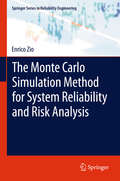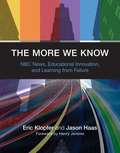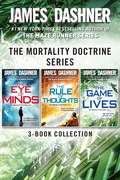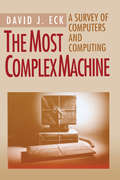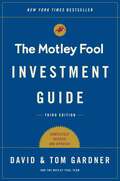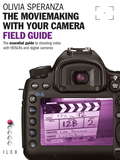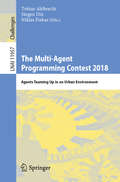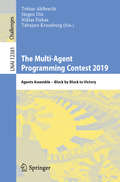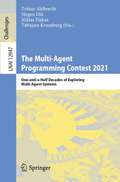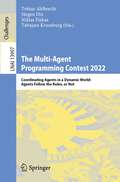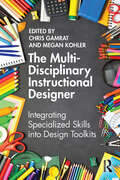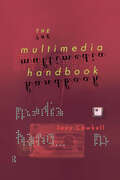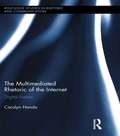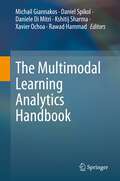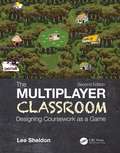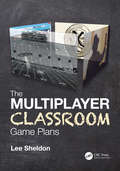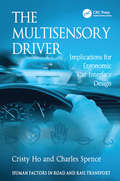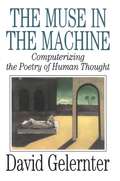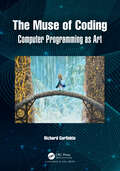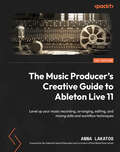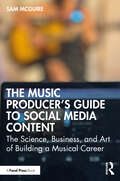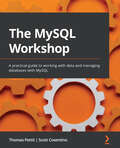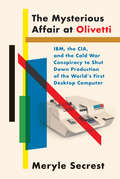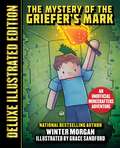- Table View
- List View
The Monte Carlo Simulation Method for System Reliability and Risk Analysis
by Enrico ZioMonte Carlo simulation is one of the best tools for performing realistic analysis of complex systems as it allows most of the limiting assumptions on system behavior to be relaxed. The Monte Carlo Simulation Method for System Reliability and Risk Analysis comprehensively illustrates the Monte Carlo simulation method and its application to reliability and system engineering. Readers are given a sound understanding of the fundamentals of Monte Carlo sampling and simulation and its application for realistic system modeling. Whilst many of the topics rely on a high-level understanding of calculus, probability and statistics, simple academic examples will be provided in support to the explanation of the theoretical foundations to facilitate comprehension of the subject matter. Case studies will be introduced to provide the practical value of the most advanced techniques. This detailed approach makes The Monte Carlo Simulation Method for System Reliability and Risk Analysis a key reference for senior undergraduate and graduate students as well as researchers and practitioners. It provides a powerful tool for all those involved in system analysis for reliability, maintenance and risk evaluations.
The More We Know
by Eric Klopfer Jason HaasIn 2006, young people were flocking to MySpace, discovering the joys of watching videos of cute animals on YouTube, and playing online games. Not many of them were watching network news on television; they got most of their information online. So when NBC and MIT launched iCue, an interactive learning venture that combined social networking, online video, and gaming in one multimedia educational site, it was perfectly in tune with the times. iCue was a surefire way for NBC to reach younger viewers and for MIT to test innovative educational methods in the real world. But iCue was a failure: it never developed an audience and was canceled as if it were a sitcom with bad ratings. In The More We Know, Eric Klopfer and Jason Haas, both part of the MIT development team, describe the rise and fall of iCue and what it can teach us about new media, old media, education, and the challenges of innovating in educational media. Klopfer and Haas show that iCue was hampered by, among other things, an educational establishment focused on "teaching to the test," television producers uncomfortable with participatory media, and confusion about the market. But this is not just a cautionary tale; sometimes more can be learned from an interesting failure than a string of successes. Today's educational technology visionaries (iPads for everyone!) might keep this lesson in mind.
The Mortality Doctrine Series: The Complete Trilogy (The Mortality Doctrine)
by James DashnerFrom James Dashner, #1 New York Times bestselling author of the Maze Runner series, comes the complete collection of all three books in the bestselling Mortality Doctrine series— The Eye of Minds, The Rule of Thoughts, and The Game of Lives. This edge-of-your-seat cyber-adventure trilogy is the perfect gift for fans of Marie Lu and Brandon Sanderson. The VirtNet offers total mind and body immersion, and the more hacking skills you have, the more fun it is. Why bother following the rules when it’s so easy to break them? But some rules were made for a reason. Some technology is too dangerous to fool with. And one gamer has been doing exactly that, with murderous results. The government knows that to catch a hacker, you need a hacker. And they’ve been watching Michael. If he accepts their challenge, Michael will need to go off the VirtNet grid, to the back alleys and corners of the system human eyes have never seen—and it’s possible that the line between game and reality will be blurred forever. Also look for James Dashner's Maze Runner series— The Maze Runner, The Scorch Trials, The Death Cure, The Kill Order, and The Fever Code. The first and second books, The Maze Runner and The Scorch Trials, are now major motion pictures featuring the star of MTV's Teen Wolf, Dylan O'Brien; Kaya Scodelario; Aml Ameen; Will Poulter; and Thomas Brodie-Sangster!
The Most Complex Machine: A Survey of Computers and Computing
by David J. EckThis introduction to computers presents the fundamental ideas and principles on which modern computers are built. While used as a text for courses in computer appreciation as well as introductions to computer science, the book has found a wide audience among computer users who wish to understand the basis of the machines that form and transform our society.What Computers Do • Teaching Silicon to Compute • Building a Computer •†Theoretical Computers • Real Computers • Programming • Subroutines and Recursion • Real Programming Languages • Applications • Cooperating Computers • Graphics • Artificial Intelligence • Answers • The text is supplemented by a web site that gives access to other problems and projects.
The Motley Fool Investment Guide: How the Fools Beat Wall Street's Wise Men and How You Can Too
by David Gardner Tom GardnerA completely revised and updated edition of an investing classic to help readers make sense of investing today, full of “solid information and advice for individual investors” (The Washington Post).Today, anyone can be an informed investor, and once you learn to tune out the hype and focus on meaningful factors, you can beat the Street. The Motley Fool Investment Guide, completely revised and updated with clear and witty explanations, deciphers all the current information—from evaluating individual stocks to creating a diverse investment portfolio. David and Tom Gardner have investing ideas for you, no matter how much time or money you have. This new edition of The Motley Fool Investment Guide is designed for today’s investor, sophisticate and novice alike, with the latest information on: —Finding high-growth stocks that will beat the market over the long term —Identifying volatile young companies that traditional valuation measures may miss —Using online sources to locate untapped wellsprings of vital information The Motley Fool rose to fame in the 1990s, based on its early recommendations of stocks such as Amazon.com, PayPal, eBay, and Starbucks. Now this revised edition is tailored to help investors tackle today’s market. “If you’ve been looking for a basic book on investing in the stock market, this is it...The Gardners help empower the amateur investor with tools and strategies to beat the pros” (Chicago Tribune).
The Moviemaking with Your Camera Field Guide: The Essential Guide to Shooting Video with HDSLRs and Digital Cameras (Field Guide Ser.)
by Olivia SperanzaAny photographer with a modern digital camera can be a moviemaker, and this book shows you all the skills you'll need to shoot everything, from a video-blog to a feature film. Build on your photographic skills - this knowledge predisposes you to create great cinematography - and understand the technical and practical necessities of high-definition video.The Moviemaking With Your Camera Field Guide shows you how you can build on what you already know to create truly spectacular movies with your DSLR in whatever genre you choose. It introduces everything from the language of film and basic equipment you will need, to the art of post-production and publishing your new work.Exclusive video content to accompany this book is available online.
The Multi-Agent Programming Contest 2018: Agents Teaming Up in an Urban Environment (Lecture Notes in Computer Science #11957)
by Jürgen Dix Tobias Ahlbrecht Niklas FiekasThis book constitutes the 13th edition of the annual Multi-Agent Programming Contest, MAPC2018, and presents its participants. The 2018 scenario and all its changes from previous competitions are described in the first contribution, together with a brief description and analysis of the five participating teams and a closer look at the matches. It is followed by a contribution from each team, introducing their methods and tools used to create their agent team and analyzing their performance and the contest.
The Multi-Agent Programming Contest 2019: Agents Assemble – Block by Block to Victory (Lecture Notes in Computer Science #12381)
by Jürgen Dix Tobias Ahlbrecht Niklas Fiekas Tabajara KrausburgThis book constitutes the 14th edition of the annual Multi-Agent Programming Contest, MAPC 2019, and presents its participants.The 2019 scenario and all its changes from previous competitions are described in the first contribution, together with a brief description and analysis of the five participating teams and a closer look at the matches. It is followed by a contribution from each team, introducing their methods and tools used to create their agent team and analyzing their performance and the contest.
The Multi-Agent Programming Contest 2021: One-and-a-Half Decades of Exploring Multi-Agent Systems (Lecture Notes in Computer Science #12947)
by Jürgen Dix Tobias Ahlbrecht Niklas Fiekas Tabajara KrausburgThis book constitutes the 15th edition of the annual Multi-Agent Programming Contest, MAPC 2020. It gives an overview of the competition, describes the current scenario. Furthermore, it summarises this year's participants and their approaches and analyses some of the matches played and the contest as a whole. In the second part, each team contributed a paper describing their approach and experiences with creating a team of agents to participate in the contest.
The Multi-Agent Programming Contest 2022: Coordinating Agents in a Dynamic World: Agents Follow the Rules, or Not (Lecture Notes in Computer Science #13997)
by Jürgen Dix Tobias Ahlbrecht Niklas Fiekas Tabajara KrausburgThis book constitutes the 16th edition of the annual Multi-Agent Programming Contest, MAPC 2022. It gives an overview of the competition, describes the current scenario. The first paper describes the contest in general and this edition in particular, focusing on the organizers’ observations. The following papers are written by the participants of the contest, describing their team of agents and its performance in more detail.
The Multi-Disciplinary Instructional Designer: Integrating Specialized Skills into Design Toolkits
by Chris Gamrat Megan KohlerThe Multi-Disciplinary Instructional Designer explores how the instructional design and development process can be energized and deepened through principles gleaned from other fields of academic study. Despite their shared academic preparation and theoretical foundations, many instructional designers come to the profession also bearing formative knowledge from a diverse range of other subject areas, career tracks, creative practices, or intellectual pursuits. Their training, however, typically does not prepare them to leverage these specializations into the creation of more effective educational experiences and materials. This first-of-its-kind book guides instructional designers to apply key concepts, strategies, and lessons learned from a variety of disciplines – spanning the social sciences, arts and humanities, and STEM – to their practice. Chapters replete with example scenarios, reflection activities, and field-tested strategies provide an expansive yet actionable reframing of the profession’s potential. By seeking inspiration across disciplines and from the world at large, instructional designers will emerge with robust and revitalized toolkits, ready to enrich their approach to teaching and learning.
The Multi-Disciplinary Instructional Designer: Integrating Specialized Skills into Design Toolkits
by Chris Gamrat Megan KohlerThe Multi-Disciplinary Instructional Designer explores how the instructional design and development process can be energized and deepened through principles gleaned from other fields of academic study. Despite their shared academic preparation and theoretical foundations, many instructional designers come to the profession also bearing formative knowledge from a diverse range of other subject areas, career tracks, creative practices, or intellectual pursuits. Their training, however, typically does not prepare them to leverage these specializations into the creation of more effective educational experiences and materials. This first-of-its-kind book guides instructional designers to apply key concepts, strategies, and lessons learned from a variety of disciplines – spanning the social sciences, arts and humanities, and STEM – to their practice. Chapters replete with example scenarios, reflection activities, and field-tested strategies provide an expansive yet actionable reframing of the profession’s potential. By seeking inspiration across disciplines and from the world at large, instructional designers will emerge with robust and revitalized toolkits, ready to enrich their approach to teaching and learning.
The Multimedia Handbook
by Tony CawkellThe Multimedia Handbook provides a comprehensive guide to the wide range of uses of multimedia. The first part of the book introduces the technology for the non-specialist. Part Two covers multimedia applications and markets. Tony Cawkell details the huge array of authoring software which is now available, as well as the distribution of multimedia data by telephone, cable, satellite or radio communications. There is an extensive bibliography, a glossary of technical terms and acronyms and a full index.
The Multimediated Rhetoric of the Internet: Digital Fusion (Routledge Studies in Rhetoric and Communication #10)
by Carolyn HandaThis project is a critical, rhetorical study of the digital text we call the Internet, in particular the style and figurative surface of its many pages as well as the conceptual, design patterns structuring the content of those same pages. Handa argues that as our lives become increasingly digital, we must consider rhetoric applicable to more than just printed text or to images. Digital analysis demands our acknowledgement of digital fusion, a true merging of analytic skills in many media and dimensions. CDs, DVDs, and an Internet increasingly capable of streaming audio and video prove that literacy today means more than it used to, namely the ability to understand information, however presented. Handa considers pedagogy, professional writing, hypertext theory, rhetorical studies, and composition studies, moving analysis beyond merely "using" the web towards "thinking" rhetorically about its construction and its impact on culture. This book shows how analyzing the web rhetorically helps us to understand the inescapable fact that culture is reflected through all media fused within the parameters of digital technology.
The Multimodal Learning Analytics Handbook
by Michail Giannakos Daniel Spikol Daniele Di Mitri Kshitij Sharma Xavier Ochoa Rawad HammadThis handbook is the first book ever covering the area of Multimodal Learning Analytics (MMLA). The field of MMLA is an emerging domain of Learning Analytics and plays an important role in expanding the Learning Analytics goal of understanding and improving learning in all the different environments where it occurs. The challenge for research and practice in this field is how to develop theories about the analysis of human behaviors during diverse learning processes and to create useful tools that could augment the capabilities of learners and instructors in a way that is ethical and sustainable. Behind this area, the CrossMMLA research community exchanges ideas on how we can analyze evidence from multimodal and multisystem data and how we can extract meaning from this increasingly fluid and complex data coming from different kinds of transformative learning situations and how to best feed back the results of these analyses to achieve positive transformative actions on those learning processes. This handbook also describes how MMLA uses the advances in machine learning and affordable sensor technologies to act as a virtual observer/analyst of learning activities. The book describes how this “virtual nature” allows MMLA to provide new insights into learning processes that happen across multiple contexts between stakeholders, devices and resources. Using such technologies in combination with machine learning, Learning Analytics researchers can now perform text, speech, handwriting, sketches, gesture, affective, or eye-gaze analysis, improve the accuracy of their predictions and learned models and provide automated feedback to enable learner self-reflection. However, with this increased complexity in data, new challenges also arise. Conducting the data gathering, pre-processing, analysis, annotation and sense-making, in a way that is meaningful for learning scientists and other stakeholders (e.g., students or teachers), still pose challenges in this emergent field. This handbook aims to serve as a unique resource for state of the art methods and processes. Chapter 11 of this book is available open access under a CC BY 4.0 license at link.springer.com.
The Multiplayer Classroom: Designing Coursework as a Game
by Lee SheldonGo beyond gamification’s badges and leaderboards with the new edition of the book, first published in 2011, that helped transform education. Going far beyond the first edition of The Multiplayer Classroom, forthrightly examining what worked and what didn’t over years of development, here are the tools to design any structured learning experience as a game to engage your students, raise their grades, and ensure their attendance. Suitable for use in the classroom or the boardroom, this book features a reader-friendly style that introduces game concepts and vocabulary in a logical way. Also included are case studies, both past and present, from others teaching in their own multiplayer classrooms around the world. You don't need any experience making games or even playing games to use this book. You don’t even need a computer. Yet, you will join many hundreds of educators who have learned how to create multiplayer games for any age on any subject. Lee Sheldon began his writing career in television as a writer-producer, eventually writing more than 200 shows ranging from Charlie’s Angels (writer) to Edge of Night (head writer) to Star Trek: The Next Generation (writer-producer). Having written and designed more than 40 commercial and applied video games, Lee spearheaded the first full writing for games concentration in North America at Rensselaer Polytechnic Institute and the second writing concentration at Worcester Polytechnic Institute, where he is now a professor of practice. Lee is a regular lecturer and consultant on game design and writing in the United States and abroad. His most recent commercial game, the award-winning The Lion’s Song, is currently on Steam.
The Multiplayer Classroom: Game Plans
by Lee SheldonThe Multiplayer Classroom: Game Plans is a companion to The Multiplayer Classroom: Designing Coursework as a Game, now in its second edition from CRC Press. This book covers four multiplayer classroom projects played in the real world in real time to teach and entertain. They were funded by grants or institutions, collaborations between Lee Sheldon, as writer/designer, and subject matter experts in various fields. They are written to be accessible to anyone--designer, educator, or layperson--interested in game-based learning. The subjects are increasingly relevant in this day and age: physical fitness, Mandarin, cybersecurity, and especially an online class exploring culture and identity on the internet that is unlike any online class you have ever seen. Read the annotated, often-suspenseful stories of how each game, with its unique challenges, thrills, and spills, was built. Lee Sheldon began his writing career in television as a writer-producer, eventually writing more than 200 shows ranging from Charlie’s Angels (writer) to Edge of Night (head writer) to Star Trek: The Next Generation (writer-producer). Having written and designed more than forty commercial and applied video games, Lee spearheaded the first full writing for games concentration in North America at Rensselaer Polytechnic Institute and the second writing concentration at Worcester Polytechnic Institute. He is a regular lecturer and consultant on game design and writing in the United States and abroad. His most recent commercial game, the award-winning The Lion’s Song, is currently on Steam. For the past two years he consulted on an "escape room in a box," funded by NASA, that gives visitors to hundreds of science museums and planetariums the opportunity to play colonizers on the moon. He is currently writing his second mystery novel.
The Multisensory Driver: Implications for Ergonomic Car Interface Design (Human Factors in Road and Rail Transport)
by Charles Spence Cristy HoDriver inattention has been identified as one of the leading causes for car accidents. The problem of distraction while driving is likely to worsen, partly due to increasingly complex in-car technologies. However, intelligent transport systems are being developed to assist drivers and to ensure a safe road environment. One approach to the design of ergonomic automobile systems is to integrate our understanding of the human information processing systems into the design process. This book aims to further the design of ergonomic multisensory interfaces using research from the fast-growing field of cognitive neuroscience. It focuses on two aspects of driver information-processing in particular: multisensory interactions and the spatial distribution of attention in driving. The Multisensory Driver provides interface design guidelines together with a detailed review of current cognitive neuroscience and behavioural research in multisensory human perception, which will help the development of ergonomic interfaces. The discussion on spatial attention is particularly relevant for car interface designers, but it will also appeal to cognitive psychologists interested in spatial attention and the applications of these theoretical research findings. Giving a detailed description of a cohesive series of psychophysical experiments on multisensory warning signals, conducted in both laboratory and simulator settings, this book provides an approach for those in the engineering discipline who wish to test their systems with human observers.
The Muse in the Machine
by David GelernterThe author, one of the leaders in artificial intelligence research, begins with the question: can we introduce emotion into the computer? In providing an answer, he not only points to a future revolution in computers but changes views about the human mind. He shows that emotions are more important than logic in determining the form and content of much of daily human thoughts. Analyzing recent psychological research and ancient literary texts, he makes a case for the similarity in the thinking of children and that of ancient peoples, in that they rely heavily on metaphor. He believes this way of thought is richer and more valuable than has been assumed and can lead to the creation of revolutionary new artificial intelligence systems. Annotation c. by Book News, Inc. , Portland, Or.
The Muse of Coding: Computer Programming as Art
by Richard GarfinkleThis book gives students and experienced programmers a way to see coding as an art and themselves as artists whose personal views, experiences, and ways of thinking can make their programs better for themselves and their users.This book shows in a good-humored and sympathetic way how the artistic and practical sides of programming are the same, delving into the methods of coding, the history of art, and the ways in which artists and audiences interact and benefit each other.Not confined to a single language or style of coding, this book provides a widely applicable framework for people to learn what languages and styles work best for them at present and as the field evolves. It can be used as a classroom text or for personal study and enrichment.
The Music Producer's Creative Guide to Ableton Live 11: Level up your music recording, arranging, editing, and mixing skills and workflow techniques
by Anna Lakatos Ski OakenfullExpert guidance on enhancing your live music production skills with MIDI, audio sequencing and arrangement techniques, automation, modulation, MPE, and external instruments from an Ableton Certified TrainerKey FeaturesMake the most of Ableton Live 11 tools and processes to create, record and edit your own musicEngage with non-linear workflow for both music production and live performanceUnveil the best solutions to common pitfalls and mistakes committed by Ableton Live usersPurchase of the print or Kindle book includes a free PDF eBookBook DescriptionThe Music Producer's Guide to Ableton Live will help you sharpen your production skills and gain a deeper understanding of the Live workflow. If you are a music maker working with other digital audios workstations (DAWs) or experienced in Ableton Live, perhaps earlier versions, you'll be able to put your newfound knowledge to use right away with this book.You'll start with some basic features and workflows that are more suitable for producers from another DAW looking to transfer their skills to Ableton Live 11.2. As you explore the Live concept, you'll learn to create expressive music using Groove and MIDI effects and demystify Live 11's new workflow improvements, such as Note Chance and Velocity Randomization. The book then introduces the Scale Mode, MIDI Transform tools, and other key features that can make composition and coming up with melodic elements easier than ever before. It will also guide you in implementing Live 11's new and updated effects into your current workflow.By the end of this Ableton Live book, you'll be able to implement advanced production and workflow techniques and amplify live performance capabilities with what the Live 11 workflow has to offer.What you will learnUnderstand the concept of Live, the workflow of recording and editing audio and MIDI, and warpingUse Groove, MIDI effects, and Live 11's new workflow enhancements to create innovative musicUse audio to MIDI conversion tools to translate and generate ideas quicklyEmploy Live's automation and modulation capabilities and project organization techniques to speed up your workflowUtilize MIDI Polyphonic Expression to create evolving sounds and texturesAdopt advanced techniques for production and discover the capabilities of live performanceWho this book is forIf you are a music producer, enthusiast, or hobbyist with a basic understanding of using Ableton Live for simple projects, this Ableton Live 11 book will help you improve your skills to employ the best features and techniques in your projects. This book is also for producers familiar with other DAWs looking to leverage their transferable skills to learn Ableton Live.
The Music Producer's Guide to Social Media Content: The Science, Business, and Art of Building a Musical Career
by Sam McGuireThe Music Producer's Guide to Social Media Content offers essential insights into the role of audio in content creation for social media platforms. It provides advice on succeeding in the music industry through the successful adoption of social media practices, and on creating high-quality content as a vehicle of career growth.Introducing both industry-standard tools, including DAWs, plug-ins and hardware, and an array of advanced techniques—such as consideration of immersive and spatial audio as well as live-streaming systems—the book equips readers to create audio for uploaded and streamed media. With a focus on maximizing quality, the book explores destinations and distribution with contemporary case studies, while focusing on principles that can be transferred to new technologies as they are released. Throughout, readers gain an understanding of the technology behind media creation, methods of using social media platforms to expand career opportunities, and the process of monetizing content.This is an invaluable companion for both novice and experienced music producers who are seeking to promote their work on social media, as well as those looking to master the art of creating audio content for social media.
The MySQL Workshop: A practical guide to working with data and managing databases with MySQL
by Thomas Pettit Scott CosentinoLearning MySQL just got a whole lot easier, thanks to this hands-on workshop, complete with simple explanations, engaging examples, and realistic exercises that focus on helping you to build and maintain databases effectivelyKey FeaturesLearn how to set up and maintain a MySQL databaseRun SQL queries to create, retrieve, and manipulate dataUse MySQL effectively with common business applications such as Excel and MS AccessBook DescriptionDo you want to learn how to create and maintain databases effectively? Are you looking for simple answers to basic MySQL questions as well as straightforward examples that you can use at work? If so, this workshop is the right choice for you.Designed to build your confidence through hands-on practice, this book uses a simple approach that focuses on the practical, so you can get straight down to business without having to wade through pages and pages of dull, dry theory.As you work through bite-sized exercises and activities, you'll learn how to use different MySQL tools to create a database and manage the data within it. You'll see how to transfer data between a MySQL database and other sources, and use real-world datasets to gain valuable experience of manipulating and gaining insights from data. As you progress, you'll discover how to protect your database by managing user permissions and performing logical backups and restores.If you've already tried to teach yourself SQL, but haven't been able to make the leap from understanding simple queries to working on live projects with a real database management system, The MySQL Workshop will get you on the right track.By the end of this MySQL book, you'll have the knowledge, skills, and confidence to advance your career and tackle your own ambitious projects with MySQL.What you will learnUnderstand the concepts of relational databases and document storesUse SQL queries, stored procedures, views, functions, and transactionsConnect to and manipulate data using MS Access, MS Excel, and Visual Basic for Applications (VBA)Read and write data in the CSV or JSON format using MySQLManage data while running MySQL Shell in JavaScript modeUse X DevAPI to access a NoSQL interface for MySQLManage user roles, credentials, and privileges to keep data securePerform a logical database backup with mysqldump and mysqlpumpWho this book is forThis book is for anyone who wants to learn how to use MySQL in a productive, efficient way. If you're totally new to MySQL, it'll help you get started or if you've used MySQL before, it'll fill in any gaps, consolidate key concepts, and offer valuable hands-on practice. Prior knowledge of simple SQL or basic programming techniques will help you in quickly grasping the concepts covered, but is not necessary.
The Mysterious Affair at Olivetti: IBM, the CIA, and the Cold War Conspiracy to Shut Down Production of the World's First Desktop Computer
by Meryle SecrestThe never-before-told true account of the design and development of the first desktop computer by the world's most famous high-styled typewriter company, more than a decade before the arrival of the Osborne 1, the Apple 1, the first Intel microprocessor, and IBM's PC5150.The human, business, design, engineering, cold war, and tech story of how the Olivetti company came to be, how it survived two world wars and brought a ravaged Italy back to life, how after it mastered the typewriter business with the famous "Olivetti touch," it entered the new, fierce electronics race; how its first desktop compter, the P101, came to be; how, within eighteen months, it had caught up with, and surpassed, IBM, the American giant that by then had become an arm of the American government, developing advanced weapon systems; Olivetti putting its own mainframe computer on the market with its desktop prototype, selling 40,000 units, including to NASA for its lunar landings. How Olivetti made inroads into the US market by taking control of Underwood of Hartford CT as an assembly plant for Olivetti's own typewriters and future miniaturized personal computers; how a week after Olivetti purchased Underwood, the US government filed an antitrust suit to try to stop it; how Adriano Olivetti, the legendary idealist, socialist, visionary, heir to the company founded by his father, built the company into a fantastical dynasty--factories, offices, satellite buildings spread over more than fifty acres--while on a train headed for Switzerland in 1960 for supposed meetings and then to Hartford, never arrived, dying suddenly of a heart attack at fifty-eight . . . how eighteen months later, his brilliant young engineer, who had assembled Olivetti's superb team of electronic engineers, was killed, as well, in a suspicious car crash, and how the Olivetti company and the P101 came to its insidious and shocking end.
The Mystery of the Griefer's Mark: An Unofficial Minecrafters Adventure (An Unofficial Gamer's Adventure)
by Winter MorganFor every boy and girl who loves Minecraft, a brand-new illustrated edition of the bestselling novel by author Winter Morgan with 75 full-color illustrations. Steve is back and ready for more adventures! But this time the excitement lands closer to home. While walking home from the village, Steve is surprised to hear a loud BOOM! When he returns home, he finds his wheat farm destroyed and a huge crater where the wheat once grew. And his diamond sword is missing! Steve believes it&’s the act of a griefer with a lot of TNT. Devastated, Steve wants to rebuild and find his sword, but with his wheat destroyed, he must call on old friends to help him. All together again, Lucy, Max, and Henry tell harrowing stories of their treasure hunts and conquests, and Steve discusses his strategy for rebuilding. They all go to sleep, excited to begin their plans; but when they wake up, Henry is missing! Looking for Henry in the village, two of Steve&’s neighbors, Kyra and Adam, have been targeted as well: Kyra&’s barn was flooded with lava, and Adam&’s friend Thomas is missing too! Who is the griefer terrorizing Steve and the villagers? And how will Steve find the resources to rebuild his prosperous farm? With suspicion circulating and no answers to be found, Steve finds himself wrongly suspected of these crimes—and so he must discover who the mischievous griefer is before something even worse happens.
